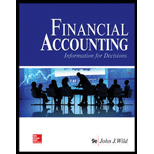
1.
Concept Introduction:
Accounting has formula that represents assets is equal to the liabilities plus owner’s equity. Each year owner’s equity is calculated by after reducing and adding the profit or loss of the year. Net Income or profit is calculated by reducing expenses from revenues.
To Calculate:
Return on assets of current year and prior year.
2.
Concept Introduction:
Accounting has formula that represents assets is equal to the liabilities plus owner’s equity. Each year owner’s equity is calculated by after reducing and adding the profit or loss of the year. Net Income or profit is calculated by reducing expenses from revenues.
To Explain:
Trend in the income of the company.
3.
Concept Introduction:
Accounting has formula that represents assets is equal to the liabilities plus owner’s equity. Each year owner’s equity is calculated by after reducing and adding the profit or loss of the year. Net Income or profit is calculated by reducing expenses from revenues.
To Explain:
Return in comparison to other companies.
Want to see the full answer?
Check out a sample textbook solution
Chapter 1 Solutions
Loose Leaf for Financial Accounting: Information for Decisions
- PROBLEM 2 On July 1, 2022, LTU Contracting, Inc. purchased a new Peiner SK575 Tower Crane for a total cost of $875,000. The crane has an estimated useful life of five (5) years. For financial reporting (book) purposes, the company utilizes straight line depreciation. For tax purposes, the equipment is depreciated over five years utilizing the 200% declining balance method. A. Prepare a table that computes the book and tax depreciation for each year of the useful life and determine the difference in book value between each method at the end of each year. B. On July 1st, 2025, the company is considering selling the crane for $500,000. Compute what the gain or loss would have been at that time for both book and tax purposes.arrow_forwardPLEASE HELP AND FILL ALL CELLSarrow_forwardhi expert please help mearrow_forward
 Auditing: A Risk Based-Approach (MindTap Course L...AccountingISBN:9781337619455Author:Karla M Johnstone, Audrey A. Gramling, Larry E. RittenbergPublisher:Cengage Learning
Auditing: A Risk Based-Approach (MindTap Course L...AccountingISBN:9781337619455Author:Karla M Johnstone, Audrey A. Gramling, Larry E. RittenbergPublisher:Cengage Learning Excel Applications for Accounting PrinciplesAccountingISBN:9781111581565Author:Gaylord N. SmithPublisher:Cengage Learning
Excel Applications for Accounting PrinciplesAccountingISBN:9781111581565Author:Gaylord N. SmithPublisher:Cengage Learning EBK CONTEMPORARY FINANCIAL MANAGEMENTFinanceISBN:9781337514835Author:MOYERPublisher:CENGAGE LEARNING - CONSIGNMENT
EBK CONTEMPORARY FINANCIAL MANAGEMENTFinanceISBN:9781337514835Author:MOYERPublisher:CENGAGE LEARNING - CONSIGNMENT Financial Reporting, Financial Statement Analysis...FinanceISBN:9781285190907Author:James M. Wahlen, Stephen P. Baginski, Mark BradshawPublisher:Cengage Learning
Financial Reporting, Financial Statement Analysis...FinanceISBN:9781285190907Author:James M. Wahlen, Stephen P. Baginski, Mark BradshawPublisher:Cengage Learning Intermediate Financial Management (MindTap Course...FinanceISBN:9781337395083Author:Eugene F. Brigham, Phillip R. DavesPublisher:Cengage Learning
Intermediate Financial Management (MindTap Course...FinanceISBN:9781337395083Author:Eugene F. Brigham, Phillip R. DavesPublisher:Cengage Learning





